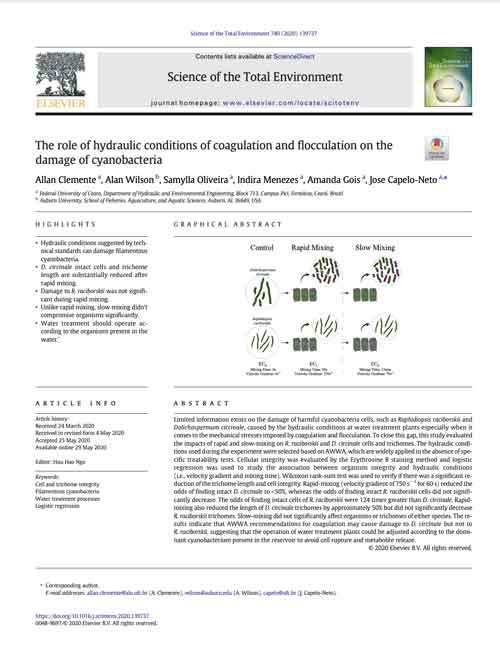
Citation
Clemente, A., A. E. Wilson, S. Oliveira, I. Menezes, A. Gois, and J. Capelo-Neto. 2020. The role of hydraulic conditions of coagulation and flocculation on the damage of cyanobacteria. Science of the Total Environment 740:139737.
Abstract
Limited information exists on the damage of harmful cyanobacteria cells, such as Raphidiopsis raciborskii and Dolichospermum circinale, caused by the hydraulic conditions at water treatment plants especially when it comes to the mechanical stresses imposed by coagulation and flocculation. To close this gap, this study evaluated the impacts of rapid and slow-mixing on R. raciborskii and D. circinale cells and trichomes. The hydraulic conditions used during the experiment were selected based on AWWA, which are widely applied in the absence of specific treatability tests. Cellular integrity was evaluated by the Erythrosine B staining method and logistic regression was used to study the association between organism integrity and hydraulic conditions (i.e., velocity gradient and mixing time). Wilcoxon rank-sum test was used to verify if there was a significant reduction of the trichome length and cell integrity. Rapid-mixing (velocity gradient of 750 s−1 for 60 s) reduced the odds of finding intact D. circinale to <50%, whereas the odds of finding intact R. raciborskii cells did not significantly decrease. The odds of finding intact cells of R. raciborskii were 124 times greater than D. circinale. Rapid mixing also reduced the length of D. circinale trichomes by approximately 50% but did not significantly decrease R. raciborskii trichomes. Slow-mixing did not significantly affect organisms or trichomes of either species. The results indicate that AWWA recommendations for coagulation may cause damage to D. circinale but not to R. raciborskii, suggesting that the operation of water treatment plants could be adjusted according to the dominant cyanobacterium present in the reservoir to avoid cell rupture and metabolite release